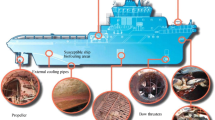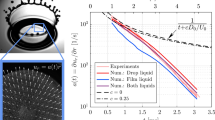Abstract
Reversible, suction based adhesion employed by many marine organisms may provide unique, adaptable technologies for biologically inspired grasping devices that function in difficult submerged environments. Here a theoretical framework based on measurable structural, material, and topological properties is developed to better understand a critical aspect of suction based attachment strategies: the leakage rate. The utility of the approach is demonstrated on an experimental apparatus designed to mimic the flow conditions experienced by a suction-based attachment device. Furthermore, the sealing effectiveness of a remora fish on sharkskin is investigated as a biological example.
Similar content being viewed by others
References
Czernik, D.E., Internal Combustion Engine Gaskets, in Gaskets and Gasketed Joints, J.H. Bickford, Editor. 1997, Marcel Dekker, Inc.: New York, NY.
Fisher, E.W., Packing and Seals, in Marks’ Standard Handbook for Mechanical Engineers, E.A. Avallone and T.B. III, Editors. 1987, McGraw-Hill Inc.: New York, NY.
Wainwright, D.K., et al., Stick tight: suction adhesion on irregular surfaces in the northern clingfish. Biology Letters, 2013. 9(3).
Ditsche, P., D.K. Wainwright, and A.P. Summers, Attachment to challenging substrates – fouling, roughness and limits of adhesion in the northern clingfish (Gobiesox maeandricus). The Journal of Experimental Biology, 2014. 217(14): p. 2548–2554.
Byern, J.v. and I. Grunwald, Biological Adhesive Systems. 2010, New York: Springer Science.
Smith, A.M., Cephalopod sucker design and the physical limits to negative pressure. Journal of Experimental Biology, 1996. 199(4): p. 949–958.
Fulcher, B.A. and P.J. Motta, Suction disk performance of echeneid fishes. Canadian Journal of Zoology-Revue Canadienne De Zoologie, 2006. 84(1): p. 42–50.
Davenport, J. and V. Thorsteinsson, Sucker Action in the Lumpsucker Cyclopterus-Lumpus L. Sarsia, 1990. 75(1): p. 33–42.
Gibson, R.N., Powers of adhesion in Liparis montagui (Donovan) and other shore fish. Journal of Experimental Marine Biology and Ecology, 1969. 3(2): p. 179–190.
De Meyer, J. and T. Geerinckx, Using the Whole Body as a Sucker: Combining Respiration and Feeding with an Attached Lifestyle in Hill Stream Loaches (Balitoridae, Cypriniformes). Journal of Morphology, 2014. 275(9): p. 1066–1079.
Persson, B.N.J., et al., On the nature of surface roughness with application to contact mechanics, sealing, rubber friction and adhesion. Journal of Physics-Condensed Matter, 2005. 17(1): p. R1–R62.
Persson, B.N.J. and C. Yang, Theory of the leak-rate of seals. Journal of Physics-Condensed Matter, 2008. 20(31).
Strasburg, D.W., Some Aspects of the Feeding Behavior of Remora remora. Pacific Science, 1962. 16(2): p. 202–206.
Ritter, E.K., Analysis of sharksucker, Echeneis naucrates, induced behavior patterns in the blacktip shark, Carcharhinus limbatus. Environmental Biology of Fishes, 2002. 65(1): p. 111–115.
Ritter, E.K. and J.M. Brunnschweiler, Do Sharksuckers, Echeneis naucrates, Induce Jump Behaviour in Blacktip Sharks, Carcharhinus limbatus? Marine and Freshwater Behaviour and Physiology, 2003. 36(2): p. 111–113.
Williams Jr, E.H., et al., Echeneid–sirenian associations, with information on sharksucker diet. Journal of Fish Biology, 2003. 63(5): p. 1176–1183.
Sazima, I. and A. Grossman, Turtle riders: remoras on marine turtles in Southwest Atlantic. Neotropical Ichthyology, 2006. 4(1): p. 123–126.
Weihs, D., F.E. Fish, and A.J. Nicastro, Mechanics of Remora Removal by Dolphin Spinning. Marine Mammal Science, 2007. 23(3): p. 707–714.
Silva-Jr, J.M. and I. Sazima, Whalesuckers and a spinner dolphin bonded for weeks: does host fidelity pay off? Biota Neotropica, 2003. 3(2): p. 1–5.
Cressey, R.F. and E.A. Lachner, The parasitic copepod diet and life history of diskfishes (Echeneidae). Copeia, 1970. 1970(2): p. 310–318.
Culler, M., K.A. Ledford, and J.H. Nadler. The role of topology and tissue mechanics in remora attachment. in MRS Fall Meeting 2013. 2013. Boston, MA.
Nadler, J.H., et al. Structures and Function of Remora Adhesion. in MRS Spring Meeting 2013. 2013. San Fransisco, CA.
Kier, W.M. and A.M. Smith, The structure and adhesive mechanism of octopus suckers. Integrative and Comparative Biology, 2002. 42(6): p. 1146–1153.
Persson, B.N.J., et al., Contact area between a viscoelastic solid and a hard, randomly rough, substrate. The Journal of Chemical Physics, 2004. 120(18): p. 8779–8793.
Chen, P.Y., J. McKittrick, and M.A. Meyers, Biological materials: Functional adaptations and bioinspired designs. Progress in Materials Science, 2012. 57(8): p. 1492–1704.
Beckert, M., B.E. Flammang, and J.H. Nadler, Theoretical and computational fluid dynamics of an attached remora (Echeneis naucrates). 2014.
Beckert, M., B.E. Flammang, and J.H. Nadler, Remora fish suction pad attachment is enhanced by spinule friction. Journal of Experimental Biology, 2015. 218(22): p. 3551–3558.
Vorburger, T.V., Methods for Characterizing Surface Topology. Tutorials in Optics: Osa Annual Meeting, Rochester NY, ed. D.T. Moore. 1992, Washington DC: Optical Society of America.
Fung, Y.C., Biomechanics Mechanical Properties of Living Tissues. 1993: Springer-Verlag New York Inc.
Lakes, R.S., Viscoelastic Solids. 1999, Boca Raton, FL: CRC Press.
Krouskop, T.A., et al., Elastic moduli of breast and prostate tissues under compression. Ultrasonic Imaging, 1998. 20(4): p. 260–274.
Guarnieri, F.A. and A. Cardona, 3D Solid Incompressible Viscoelastic Finite Element in Large Strains for the Cornea. Mechanica Computacional, 1997. 18: p. 799–808.
Liu, Z. and L. Bilston, On the viscoelastic character of liver tissue: experiments and modelling of the linear behaviour. Biorheology, 2000. 37(3): p. 191–201.
Kiss, M.Z., T. Varghese, and T.J. Hall, Viscoelastic characterization of in vitro canine tissue. Physics in Medicine and Biology, 2004. 49(18): p. 4207–4218.
Haghpanahi, M. and H.A. Naeeni. Investigation of Viscoelastic Properties of Human Liver Tissue Using MR Elastography and FE Modeling. in Proceedings of the 17th Iranian Conference of Biomedical Engineering. 2010.
Chatelin, S., et al., In vivo liver tissue mechanical properties by transient elastography: Comparison with dynamic mechanical analysis. Biorheology, 2011. 48(2): p. 75–88.
Cowin, S.C. and S.B. Doty, Tissue Mechanics. 2007: Springer Science.
Biot, M.A., General theory of three-dimensional consolidation. Journal of Applied Physics, 1941. 12(2): p. 155–164.
Mei, C.C. and B. Vernescu, Homogenization Methods for Multiscale Mechanics. 2010, 27 Warren St, Suite 401–402, Hackensack, NJ 07601: World Scientific Publishing Co.Pte.Ltd.
Dullen, F.A.L., Porous Media Fluid Transport and Pore Structure. 2nd ed. 1992, Sandiago, CA: Academic Press Inc.
Hallquist, J.O., G.L. Goudreau, and D.J. Benson, Sliding interfaces with contact-impact in large-scale Lagrangian computations. Computer Methods in Applied Mechanics and Engineering, 1985. 51(1–3): p. 107–137.
Belytschko, T., W.K. Liu, and B. Moran, Nonlinear Finite Elements for Continua and Structures. 2000: Wiley.
Hyun, S., et al., Finite-element analysis of contact between elastic self-affine surfaces. Physical Review E, 2004. 70(2).
Anderson, E.J., W.R. McGillis, and M.A. Grosenbaugh, The boundary layer of swimming fish. Journal of Experimental Biology, 2001. 204(1): p. 81–102.
ASTM, Standard Practice for Stress Relaxation Testing of Raw Rubber, Unvulcanized Rubber Compounds, and Thermoplastic Elastomers. 2012, ASTM International: West Conshohocken, PA.
Mix, A.W. and A.J. Giacomin, Standardized Polymer Durometry. Journal of Testing and Evaluation, 2011. 39(4): p. 696–705.
Sewell, R.B.S., The adhesive apparatus of the “ sucking-fish ”. Nature, 1925. 115: p. 48–49.
Shephard, K.L., Functions for Fish Mucus. Reviews in Fish Biology and Fisheries, 1994. 4(4): p. 401–429.
Roberts, S.D. and M.D. Powell, The viscosity and glycoprotein biochemistry of salmonid mucus varies with species, salinity and the presence of amoebic gill disease (vol 175, pg 1, 2004). Journal of Comparative Physiology B-Biochemical Systemic and Environmental Physiology, 2005. 175(3): p. 219–219.
Author information
Authors and Affiliations
Rights and permissions
About this article
Cite this article
Beckert, M., Flammang, B.E. & Nadler, J.H. A Model of Interfacial Permeability for Soft Seals in Marine-Organism, Suction-Based Adhesion. MRS Advances 1, 2531–2543 (2016). https://doi.org/10.1557/adv.2016.445
Published:
Issue Date:
DOI: https://doi.org/10.1557/adv.2016.445




